Maigh Eo na Sacsan
Published in Early Modern History (1500–1700), Features, Issue 2 (Summer 2001), Volume 9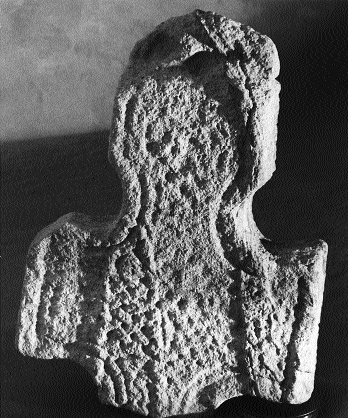
Mayo Abbey cross head depicting the type of interlace found in Irish and Anglo-Saxon gospels. (Trish Forde)
Maigh Eo na Sacsan (Mayo of the English) bears witness to the earliest contacts between Ireland and England, to an era when cultural contacts between the two countries were characterised by a mutual give and take. Tim Pat Coogan has pointed out that it was only as late as the twelfth century that ‘the influence of an English pope and his English advisors first introduced a military and political aspect to the manner in which the Christian inhabitants of the islands worshipped the same God’. In the sixteenth century, Sir Henry Sidney was responsible for the shiring of Connacht and chose Mayo of the English to lend its name to the present-day County Mayo; it was known under this name at least for one more century. The same place—Mayo Abbey or Mayo, three kilometres south of Balla, and close to Claremorris—still bears impressive imprints from its earlier days, most visibly in the remnants of a large enclosure of over 400 metres in diameter.
The origin of Mayo’s fame was a monastery founded by St Colmán of Lindisfarne in the early AD 670s. In AD 664 a synod in Whitby decided on the course the church there would take with regard to the ‘proper’ reckoning of Easter and the tonsure; the Northumbrian king Oswy ruled in favour of the Easter date then current in Rome. Faced with this decision—contrary to Irish practice—St Colmán, bishop of Lindisfarne, thereupon left his bishopric together with some Irishmen, as well as thirty Englishmen, repaired to Iona, then to Inishbofin off the west coast of Connacht, founding a monastery there. The English and Irish who constituted the community seemingly found it impossible to cohabit in harmony, and Colmán found another place for the English; thus Mayo was founded.
Ireland and early immigrants
In the period when Mayo was founded and flourished, there were quite a few Englishmen (there’s no mention of women) in Ireland: the Litany of Irish Pilgrim Saints invokes ‘the Saxons in Rigair’ and ‘the Saxons in Cluain Mucceda’. (By the eighth century all Germanic people in Britain were described in Ireland as ‘Saxons’.)
The contemporary historian Bede gives an account of Ireland’s attractions in his Ecclesiastical History of the English Nation and gives us the names of ten Englishmen who went to Ireland for shorter or longer periods of time. They went to Ireland in pursuit of religious studies or of a ‘life of stricter discipline’, and, according to Bede, were met in the most friendly and hospitable fashion—for which Bede was forever grateful, despite the Irish church’s deviation from what he considered orthodox practice.
Apart from individual names, we have proof of other predominantly Anglo-Saxon monasteries in Ireland. Mayo shares the epithet ‘of the Saxons’ with two other churches, namely Tech Saxan in today’s parish of Athenry, and Tisaxan in County Cork, near Kinsale. Rath Melsigi in Carlow, mentioned by Bede himself, and Tullylease in north west Cork also had a fair contingent of English at any given time. However, Mayo’s case is special in that it is the only monastery for which we have a documented early chronology. Not only that, but the Saxons on the ‘plain of yew trees’ (maigh eo) made their monastery a success story that has come down to us in the name of the modern county of Mayo.
Since the majority of sources about early Mayo are English, we do not know how it stood in relation to the Irish churches and monasteries surrounding it. But it could not have existed in some kind of ‘splendid isolation’. Judging by the size of its enclosure alone, the monastery was at some time in its early history on a par with sites like Armagh, Kildare, Glendalough, and Clonmacnoise, all Irish monastic ‘proto-towns’. Knowing nothing about the politics of Mayo’s growth, we have to concentrate on the cultural contributions to that growth: it was possibly Mayo’s position as an interface between two and more cultures that enabled it to gain the reputation it had later on.
The only other foreign population group in Ireland in similar numbers and also documented by place-names, were Celtic Britons, who played a role in Christianising and teaching the Irish (most notably St Patrick). The relationship was reversed with the English: most of them had been Christianised or at least influenced by the Irish, notably the Angles of Northumbria. English monks and clergy therefore came to Ireland to experience at first hand Irish teachings and the monastic life they had themselves earlier been taught.
How did the visitors from either country cope with the other’s vernacular? There were initial problems when the church of Iona first set up the missionary centre in Lindisfarne in the early seventh century. Later on the English monks at Lindisfarne, among them those who later left with Colmán for Mayo, learned from their Irish fellows about culture and society in Ireland, and words and phrases were assimilated into Anglo-Saxon. Those who followed St Colmán to Ireland spent three to four years on Iona before setting out to Inishbofin, where they also spent at least a year, probably more. They should have therefore been fluent in Irish by the time they settled in Mayo.
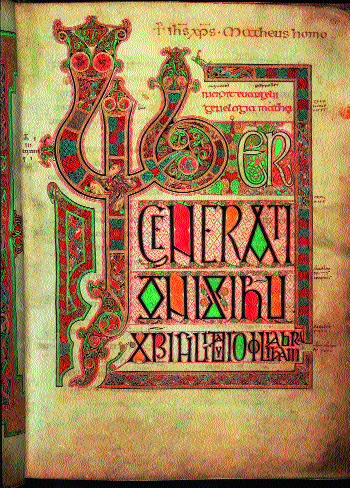
The opening page of St Matthew’s Gospel from the Lindisfarne Gospels. (British Library)
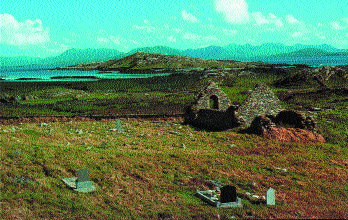
St Colmán and his English followers left Lindisfarne, first for Iona, and later founded a monastery on Inisbofin in AD 688. (Kenneth McNally)
Pilgrimage
Given these close relations, it should be no surprise that when Colmán decided to leave his bishopric in Lindisfarne, there were thirty Englishmen who shared his judgement on the matter of the choice of Easter. However, the king’s decision meant much more than a simple replacement of a ‘Celtic’ Easter with a ‘Roman’ calculation. There were many factors that played a part in Colmán’s and the other men’s decision, and the struggle fought out at Whitby seems as much a Roman-Roman struggle within the English church, as a Roman-Irish one.
The monks who followed Colmán from Iona to Inishbofin in AD 668 probably embarked on a well-prepared journey whose destination was clear from the start. No genealogical records survive to prove that Colmán was from Connacht, but there is perhaps no need for such a link: it is possible that the monastery on Inishbofin had been abandoned during the plague that ravaged Ireland and England from AD 664, (killing Fechín of Fore and many other clergy): news may have reached Iona of the monastery there being deserted, so that Colmán decided to step in. Inishbofin was a perfect destination for these pilgrims, settling where they would face the western ocean and perceive themselves as guarding the frontier of Christendom.
Differences
But then Inishbofin also brought the first intimation that the English, although brought up in Irish monastic ways, did not see eye to eye with their former teachers: while the Anglo-Saxons tilled the land the Irish went off in the summers and expected a decked table on their return. Earlier scholars had it that the Irish, being ‘bogwise’, were entrusted with the Irish custom of booleying while the English stayed at home. Yet, booleying was certainly not a habit exclusive to the Irish and was practised all over Europe. It is possible that the community had a mainland base for cattle, from which the drovers would disappear on the transhumance trail. The reputation for ‘wandering’ attached to the Irish in the early middle ages might hold clues as to what brought about the split in the Inishbofin community.
Although the stability of a community was a virtue strongly emphasised by Irish abbots, monks often strayed from their houses in search of scholarship or missionary fields. There is an Irish canon from the seventh century entreating clergy to teach one’s own country first of all. The image of Irish monks leaving their families behind is a strong one, but in fact they often returned home to preach, and even called kinsmen (or women) to their aid. These were ideals shared by the two nations, but the Irish on Inishbofin were now able to return home for long periods of time, while the English lived devoutly by the rule of St Basil of Caesarea that agriculture was the best kind of work for monks, as it kept them from wandering.
Whatever the reason for the split, Colmán now chose to accommodate his English monks elsewhere, thus their arrival in Mayo in the early 670s. The land was good for pasture and tillage, and the monastery was far enough away from any expanding secular or clerical power. Soon after leaving the English monks with their own abbot, Colmán ‘of Inishbofin’ died.
From then on the monks of Mayo had to adapt themselves to the political and social set-up around them. Irish monasteries were tightly intermeshed with and adapted to the grades of Gaelic society: Gaelicisation was inevitable. But the Anglo-Saxon monks must also have focused on their mother-country as most expatriates would. Recruitment of monks and clergy from England continued. But the byname ‘of the English’ and the Anglo-Saxon names of early rulers does not necessarily imply that there were only English in Mayo. Considering the growth of its lands, there must have been Irish tenant farmers, and the rulers of the community must have been in contact with local chieftains or kings in the process of ministering, managing lands, or in a mediary role. The Irish annals deal with Mayo as they deal with other large monasteries.
St Gerald
One of the more famous Mayo names is St Gerald. While he remains a shadowy figure, he did indeed exist in the early eighth century. We know for certain that he was an outstanding abbot, possibly also a bishop, and that he died in AD 732 (Annals of Ulster). The unreliable Life of St Gerald mentions three brothers and a sister, but though the brothers can be tracked down in contemporary martyrologies and annals, these siblings were probably ‘siblings in spirit’. The ‘brother’ who left the biggest legacy in folk memory is St Berchert of Tullylease, who is still commemorated in north Cork and Tipperary, and in whose community archaeological finds have demonstrated the exchange of skills and styles between the two nations. In Mayo we have similar evidence of an even broader confluence of styles in the head of a high cross.
Conformity
At the turn of the eighth century Mayo must have converted to the Roman Easter, when all remaining Irish churches reconciled themselves to the orthodox calculation. It would not be reasonable to assume that the community changed course soon after Colmán’s death in AD 675. This, after all, was their original raison dêtre in Ireland. With a new generation, however, around the turn of the eighth century, tempers would have settled down and the way paved for a more fruitful discussion of matters mathematical and astronomical. Also, with continued recruitment from England, the contact with the old country and awareness of divergence from its practice, would have created an urge to conform. The process in Mayo must have been drawn out, and spurred on by many voices, accompanied by heated debates as in other places.
Until the early eighth century, the organisation and hierarchies in the Mayo community may not have differed from surrounding Irish monasteries. It was half a century later when serious differences between the English and Irish churches became obvious. The English church had by then developed its own voice, and had become a missionary force like the Irish almost two centuries earlier. It is in the missionary field that we can first see the two mindsets colliding. The bone of contention was invariably the lack in Ireland of ‘proper’ dioceses and archdioceses, and therefore of authorised bodies to appeal to. The achievement of the metropolitan system in England influenced Anglo-Saxon missionaries like St Boniface: where he clashed with Irish missionaries in modern mid-Germany it was over wandering bishops without a diocese, or priest-abbots that administered a diocese with a bishop on stand-by, so to speak. This last arrangement was one famously in place on Iona, and in other large Irish monasteries; a ‘diocese’ in Ireland was a different entity from one in England.
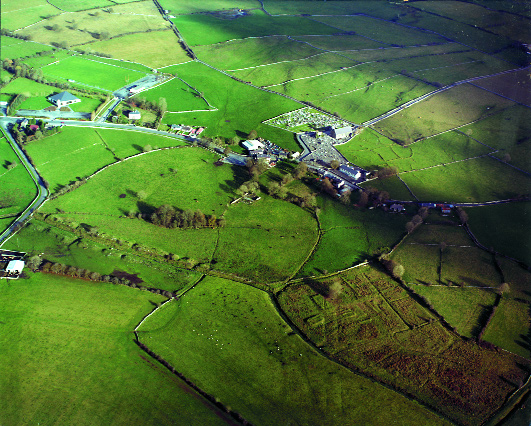
Mayo Abbey-remnants of a large enclosure (dotted line) of over 400 metres diameter are still visible. (Gerry Bracken)
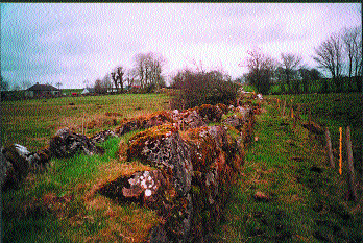
Part of the still extant enclosure wall. (Vera Orchel)
The fact that Mayo’s community had a bishop, from the AD 760s at the latest, but probably no abbot, was not entirely at odds with Irish practice. The most interesting question is how the Mayo monks and rulers perceived the difference between their mother country and their place of residence. Recruits drawn to Mayo would have derived for the most part from the north of England, where York had been made an archdiocese in AD 735. From then on new English recruits to Mayo can be assumed to have noticed differences to the clerical and monastic landscape of Ireland, and to have looked to home for guidance.
Contacts with Carolingian France
In the late eighth-century the Mayo community corresponded with Alcuin of York, who spent most of the AD 790s teaching at Charlemagne’s court on the Continent. This correspondence between Ireland, England, and Gaul may have played a part in changing the direction in which liturgies, for example, were transmitted between the countries. Alcuin’s praise for the community is striking. Their ‘service abroad ranks high with Christ’ because they had left their own country to live abroad and submitted to ‘persecution from wicked men’. ‘Be blameless and let your light shine in the midst of a most barbarous nation like a bright star in the western sky.’ The ‘wicked men’ and the ‘barbarous nation’ are not hints at anti-Irish prejudice; in another letter to the general Irish church, Alcuin also finds much to commend. The evil Alcuin cautions against was partly ‘the sinner within’ every man, and partly the ever-present threat of violence from fellow men. His first letter speaks of impending violence.
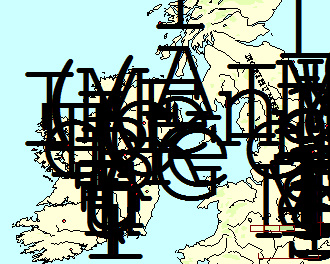
(Matthew Stout)
It is too early for Viking raids, although there was a general feeling even then of a pagan world closing in on Christianity, so the threat may have emanated from local warfare.
There was a ‘great light of knowledge’, according to Alcuin, emanating from Mayo as far as England and France: so Mayo must have developed a reputation as a monastic or cathedral school, and it certainly seems to have had the economic necessities for a good scriptorium and library. Neither have left traces behind for us to see. It is also possible that Mayo, in training its novices, took up sons of the nobility in fosterage: there is even a tradition of ninth-century King Alfred of England sending a son to Mayo.
Historians have tended to polarise the Irish and the English in this period for the former’s lack of metropolitans, for idiosyncrasies in their script and in their liturgy. The contrast invariably focused on well-known clichés: the ‘excessive’ Celts, driven by ‘whim and fancy’, and on the other side the discipline and sobriety of the Anglo-Saxons, and their closeness to the ‘cold-as-marble Roman’. In defence of the English who seem to have acquired a name for being dry and uninspired, it could be said that their communities also went off the righteous path at times, at least as Alcuin saw it. In a letter to a bishop of Lindisfarne Alcuin criticised the type of evening entertainment carried on in the monastic living quarters: he mentions a harpist, and the recital of heathen heroic legends similar to Beowulf. In the letters to Mayo he finds the community beyond reproach. But we cannot rule out that Irish legends, with or without musical accompaniment, or the visual riddles beloved by the English at the time, featured in a common cell in Anglo-Saxon Mayo, too.
The link with Northumbria
In AD 786 Ealdwulf of Mayo made the long journey to Northumbria and participated in the legatine synod of that year, after having been consecrated bishop by the archbishop of York. Two papal legates had been despatched to England to look for abuses in the church and to convene synods to root these out. Ealdwulf signed his name to maintain the twenty statutes ensuing from the northern council ‘to the utmost of his ability’. Obviously, his ability was compromised, to some extent, by his place of residence.
Most of the canons would not have been ill-placed at an Irish synod. Some of these Northumbrian abuses, like ministers appearing at mass with bare shins, or remnants of pagan customs, would have easily found equivalents in the Irish church. The greatest difference that Ealdwulf would have observed was the hierarchy in place in England (theoretically at least). Ealdwulf’s consecration itself makes it quite obvious that the rulership of Mayo sought approval and sanction from the authority they felt closest to. However, Mayo was not strictly a suffragan church of York. The connection with Northumbria was not a conventional one.
There is a big gap in the dateable sources between the late eighth century through the Viking age and to the late eleventh century. Later evidence proves that the forces of assimilation seem to have worked on the community over these centuries. As a separate enclave, it is comparable to other non-native groups subject to influences of assimilation, but with the added peculiarities of ecclesiastical law and customs. Mayo in its early history stands for both assimilation and the process of re-defining origins and differences. It helps cast invaluable light on the early interconnection between ‘these islands’, and the western European world beyond.
Vera Orschel is a history graduate of the National University of Ireland, Galway.
Further reading:
S. Allott (ed.), Alcuin of York—his Life and Letters (York 1974).
N. Chadwick, ‘Bede, St Colmán and the Irish Abbey of Mayo’, in K. Jackson et al (eds.), Celt and Saxon: Studies in the Early British Border (Cambridge 1964).
K. Hughes, ‘Evidence for contacts between the churches of the Irish and English from the Synod of Whitby to the Viking Age’, in D. Whitelock, P. Clemoes & K. Hughes (eds.), England before the Conquest (Cambridge 1971).
D. Ó Cróinín, Early Medieval Ireland 400-1200 (London 1995).
















